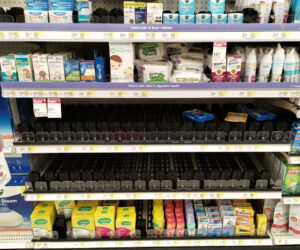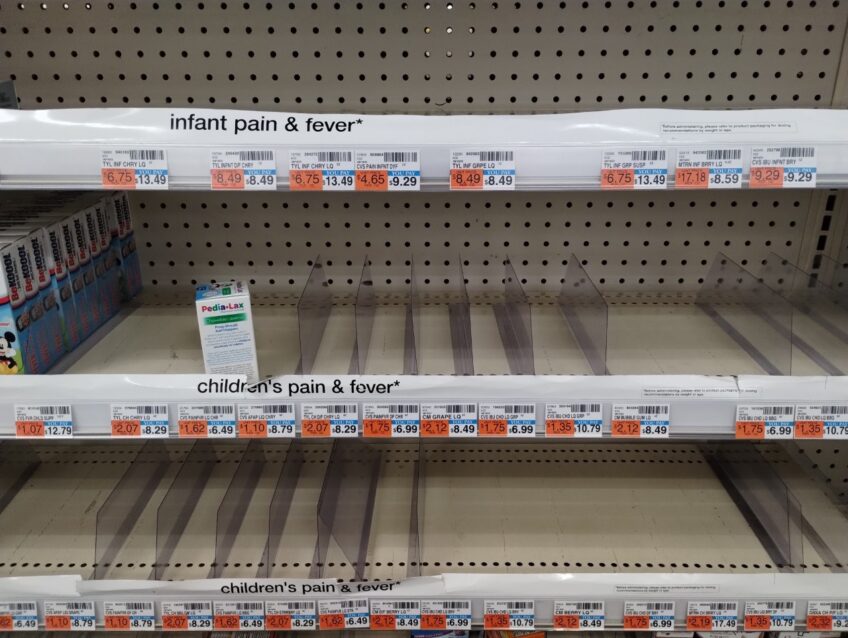After last winter, with its onset of Omicron, school closings and no Covid-19 vaccine yet available to children under two, one might have thought things could only get better for parents and their little ones. However, the challenges have continued throughout 2022 with shortages of baby formula and pediatric needles and recently a surge of fall and winter illnesses, accompanied by less availability of sick visits at understaffed pediatricians’ offices. In addition, the knock-on effect of the triad of serious viruses currently affecting children – Covid, flu and RSV – is a sudden shortage of children’s fever-reducers and pain medication.
On December 3, National Public Radio reported the present “tripledemic” means fever-reducing medicines are in short supply. The supply chain is strong, but demand is surging, they reported.
A week later, the situation seems to have worsened. I discovered this when my own 6-year-old developed a fever. It’s not always necessary to medicate for an elevated temperature, but as hers climbed over 103˚ F, and she became increasingly pained, we knew we had to treat it. Thus began several days marked by waves of fever peaking and then dipping with medicine, with tepid baths and washcloths on foreheads, buckets by bedsides, loads of laundry … and an unexpectedly difficult search for fever medication.
The first day we found children’s ibuprofen at the Co-op, but no children’s Tylenol or other acetaminophen, and no infant pain or fever medication (for the under 2s). They were also out of Pedialyte popsicles, another staple for feverish children.
The ibuprofen helped my daughter dramatically, but it can only be given every 6-8 hours. To bring relief between doses you could alternate it with acetaminophen … if you have it. We didn’t.
By Saturday morning, we had two children throwing up with fevers. This time we ventured to Greenbelt’s Target. There the racks for children’s medication were alarmingly bare – no ibuprofen or acetaminophen for the 2- to 11-year-olds. There were four packets of an ibuprofen in suppository form for infants (under age 2).
At this point I checked Amazon; their options for children’s Tylenol were: out of stock, not arriving until the new year or else hawked by third-party sellers for $20 a 4-oz. bottle, plus shipping.
On Sunday we ventured to both CVS locations on Greenbelt Road. There was a single bottle of infant ibuprofen on the shelves at the 24-hour store but nothing at all for the age 2-11 “children” group. At the second CVS there was no infant or children’s ibuprofen but there was a single bottle of children’s acetaminophen.
By Monday we had three children with fevers. One that would need infant medication and two that need children’s.
Amanda Ferouz, pharmacist at Greenbelt Co-op Pharmacy, said the Co-op Pharmacy is seeing a shortage in part because they don’t usually stock much children’s medication to begin with. There haven’t been many parents using the pharmacy for children’s medications in general but, she added, “the neighborhood is changing.”
This month there’s a sudden clamor nationwide for children’s Tylenol, in particular. “The shortages are nationwide,” said Ferouz. “It’s not because it’s not available but because it’s in higher demand.” Ferouz has managed to order some generic options and has placed an order with their wholesalers. According to Ferouz, the wholesalers themselves don’t stock that much and so they in turn will be placing orders with manufacturers. “The whole country is demanding it at the same time,” said Ferouz. She anticipates the situation improving over the next few weeks as wholesalers get stock into the supply chain and as demand hopefully drops as children get over their illnesses. In the meantime, Ferouz advises that if parents have ibuprofen they can use that. Its only disadvantage being that it needs to be given with food; they can also use fans and tepid baths or compresses to bring down fevers.


